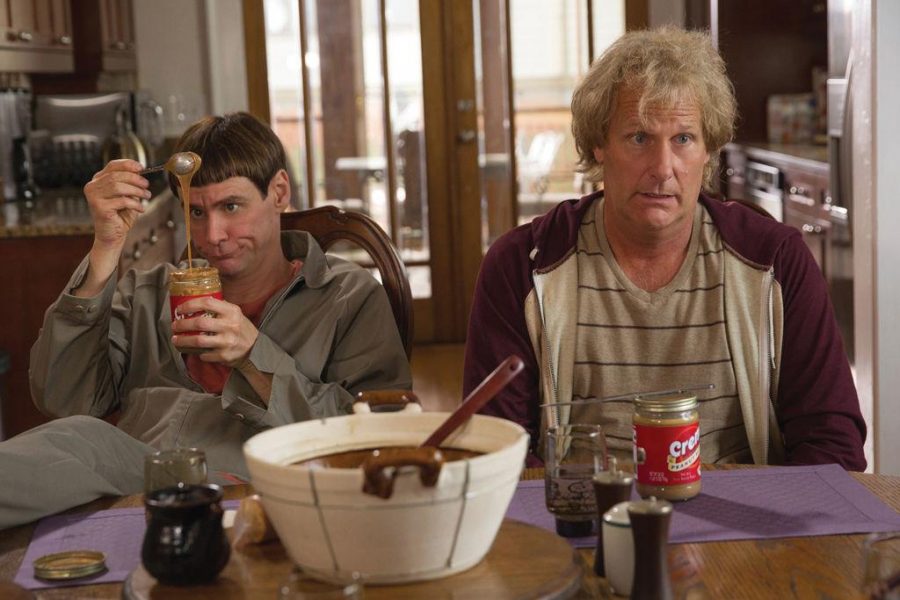‘Dumb and Dumber To’ brings the gags but lacks the heart
November 18, 2014
“Dumb and Dumber To”
Directed by: Peter Farrelly, Bobby Farrelly
Starring: Jim Carrey, Jeff Daniels, Rob Riggle
Rated: PG-13 for crude and sexual humor, partial nudity, language and some drug references
Now playing at SouthSide Works, AMC Loews Waterfront 22
Grade: C+
When the Pantheon of great comedic filmmakers is erected, it’s hard to say whether Bobby and Peter Farrelly will be there.
The siblings’ filmaking career, while never less than interesting, can be summed up with the phrase “hit-or-miss,” featuring flops like “Kingpin,” “Hall Pass” and “The Three Stooges,” and hits like “There’s Something About Mary” and “Stuck on You.”
Given this list, one thing does seem to be clear: the Farrellys’ films work best when their vile sense of humor is complemented by an undeniable sweetness. It is this well-intentioned crudeness that made “There’s Something About Mary” and “Stuck on You” work so well, and it’s the same reason why Judd Apatow’s films, such as “The 40 Year Old Virgin” and “Knocked Up,” along with those of his disciples, such as “Superbad,” “I Love You, Man” and “Get Him to the Greek,” are some of the most critically and commercially successful comedies of the last decade.
It should come as no surprise that the Farrelly brothers, one of the first practitioners of this style, used it to great effect in their first film “Dumb and Dumber,” which grossed over $200 million worldwide in 1994 and has since amassed an enormous cult following. Unfortunately, two decades of superior buddy comedies has not been kind to the pair of lovable losers. Apatow and his contemporaries have leaned heavier on the heart, so we’ve come to expect more than just a collection of sharp, quick gags.
Yes, Lloyd Christmas (Jim Carrey) and Harry Dunne (Jeff Daniels) are back for another ludicrous adventure in “Dumb and Dumber To” after spending the last 20 years at a nursing home — Lloyd as a patient and Harry as the man voluntarily in charge of changing Lloyd’s diaper. After Lloyd admits that his formative years spent at the nursing home were not the result of trauma he suffered after his failed relationship with “Mary Samsonite,” but was instead an elaborate ruse to fool Harry, Harry tells Lloyd that he is in dire need of a new kidney.
Harry finds a possible kidney source on an old postmark from a girlfriend in high school, telling him that he impregnated her and that she gave up his daughter for adoption. After this, the two screwballs embark on another road trip to track down Harry’s daughter and ask for her kidney. Once they find out the name and address of her adoptive parents, they visit the house only to find that she has already left to speak at a conference on behalf of her father, a science professor too sick to attend for himself. The two head to the conference with a package entrusted to them by the professor, which purportedly contains a world-changing invention worth billions, a package highly coveted by his gold-digger wife (Laurie Holden) and her boyfriend (Rob Riggle).
If the true measure of a screwball comedy is the number of times I laughed, then “Dumb and Dumber To” fared well. The movie holds the attention well enough and keeps the jokes coming at a more than adequate pace. Fans of the original should have no trouble enjoying this one as well, as Carrey, Daniels and the Farrelly Brothers all stay true to the original, straying little from what made it so appealing, namely the promise of incredibly stupid friends doing funny, imprudent things.
But if there is one thing we have learned from the abrasive but tender comedies of the last decade, it’s that this type of comedy can be so much more than just a series of clever gags and sketches. Perhaps the most important reason why the Apatow class of comedies works so well is that the style allows the performers room to be funny. Rather than orchestrating a collection of funny skits, the filmmakers take a step back and trust the performers to be funny without the aid of a highly calculated script. One of the important side effects of this approach is that it allows for a deeper connection to the performers on screen. While the two filmmakers’ styles may be similar in certain ways, this is one incredibly important area where they diverge. And suddenly, what seemed innovative and fresh in 1994 seems like a little old hat today.



